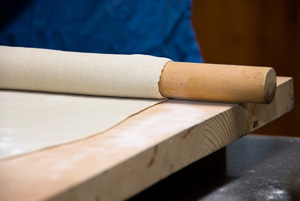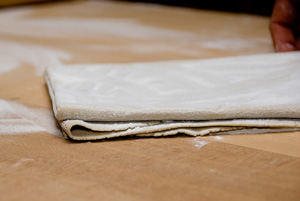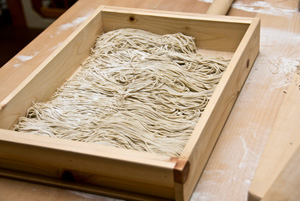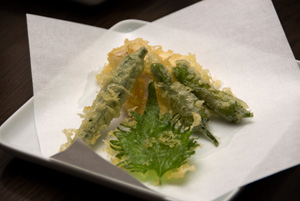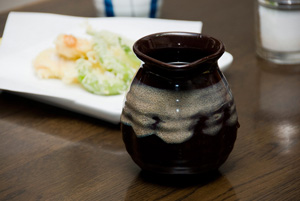Our friends Judith and Kurtis are preparing to move back to America soon and as a farewell present to them, the proprietors of our favorite soba restaurant, Shunmi, treated the four of us to a lesson in making handmade soba. We began our lesson by learning about different styles of soba.
Most soba restaurants make Edo soba, but Shunmi specializes in a type of soba known as tachi-soba. While making Edo soba is mostly practiced by men, tachi-soba is the type of soba that is made in the countryside, and the technique is often passed down by the women in the family. Edo soba is prepared by rolling out a very large sheet of dough that is folded several times and then the layers are cut using a pushing motion with a large, hooked knife with a flat blade. On the other hand, tachi-soba is cut with a different style of knife, and the knife is drawn through single sheets of dough that are stacked together. The cutting is done with just the tip of the blade. While Edo soba is cut using a guide board that ensures that each noodle is cut to an even thickness, tachi-soba is cut with no guide, so an evenly thick noodle is a sign of a skilled chef.
Shunmi prepares their noodles fresh every day, judging each morning how many customers they will get depending on the weather. They are only open at lunch and they said that they will get about 30 customers on a sunny day, but only 20 on a rainy day. They serve both ni-hachi soba, or 80% buckwheat and 20% wheat flour with a bit of egg and tororo-imo (ground yama-imo), and ju-wari soba, which is 100% buckwheat and water. After seeing how much work goes into the handmade noodles, it is amazing that we can buy their lunch set with tea, dessert, pickles, and seasonal tempura vegetables for just 1000 yen.

ready to make soba: enameled bowls filled with pure buckwheat flour
To make the soba, we began by putting 500 grams of buckwheat flour into a large laquered bowl. The water is usually about 50% of the amount of flour by weight, so we measured 250 mL into measuring cups. The amount of water needed can vary with the temperature, humidity, and other weather conditions, so it’s added gradually. First we added half the water and used our fingertips to mix the water into the flour and rub and big lumps with the flour, creating a mix that looked about like panko breadcrumbs. Then we added half of the remaining portion of water and mixed again. Our goal was to create an even mix that looked almost like beach sand. We added more water, little by little, using our fingertips to rub the pieces of dough together. When the dough bits had gathered into lumps about the size of small potatoes, we smooshed them all together and kneaded the ball until it was smooth. Then we split the dough in half, and rolled each half into a ball and rolled the ball on the side of the enamel bowl to smooth out any wrinkles. We flattened each ball into a disc and put one in plastic while we rolled the other.


Making the soba: the dough beginning to come together | the dough kneaded into a smooth ball
We rolled the dough out on a large wooden board with a long rolling pin. We were taught to push the pin with our palms, moving them in circles to press the dough and gradually rotate it on the board. After the dough is rolled into a large circle, we had to focus our rolling on the corners to create a relatively square piece about a millimeter and a half thick. My first circle didn’t start off very well, so our teachers called it the “map of the world soba.” After my troublesome first attempt I had a much better time with my second piece. I really enjoyed rolling the soba: the long, circling motions and the dry “swish swish” sound of our floury hands on the rolling pins was very meditative and relaxing.

the sheets of dough
After we had each rolled our two sheets of dough, we stacked them all together and then cut our noodles. We took turns cutting by laying our hand lightly on top of the layers of dough and using the back of our thumbs to guide the knife, cutting thin, even strips. As we drew the knife along, it was amazing to watch the noodles gracefully fall to the side, our dough becoming soba.
Next we learned to make Judith’s favorite soba topping, kurumi sauce (walnut sauce). We started with a mix of toasted sesame seeds and walnuts, about 50 mL per serving. We ground the nuts and seeds until smooth in a suribachi then added a bit of hot water to help bring out the fragrance. Finally we mixed in soba tsuyu, about 100 mL per serving, to give the sauce the proper taste and texture. It’s easy!
Oh yeah, except that the hardest part might be making a delicious tsuyu. Shunmi starts by making kaeshi, a seasoned soy sauce mixture made with soy sauce, sugar, and mirin. They age the kaeshi to develop flavor for 3 months. After that, they mix it with homemade dashi to make the finished tsuyu. Of course, they wouldn’t share their secret recipe, but they gave us a hint that they use 3 kinds of katsuo to get the proper flavor.

our soba, cooked and ready to eat – you can see that some of the noodles from the irregular ends are a little short
We finished with a lesson on how to cook the noodles properly. They use a huge pot of boiling water to cook the noodles. They cook each portion by itself, not 4 portions in the pot at once. They usually cook the noodles for just 60 seconds. Since our beginner’s noodles were a little thicker than usual, we cooked them for 70 seconds. After removing the noodles from the hot water, it’s important to wask off the excess starch by rubbing them vigorously in a colander with cold running water. Then we dipped them in a bowl of ice water. Finally the noodles were ready to serve. We piled them on a zaru (strainer) and put bowls of kurumi sauce next to them. They also made us some fall-vegetable tempura, served with regular tsuyu, and delicious pickled cabbage and cucumbers with shiso buds. They served the pickles with a yuzu-soy dressing that gave them a completely different, and of course still delicious, flavor.

The finished meal: homemade soba; eggplant, cucumber and cabbage tsukemono; tempura of fall vegetables, green beans, and kurumi (walnut) sauce
We finished the meal, as always, with a pitcher of hot soba cooking water, which is called o-yu. After you’ve eaten all of your noodles, you pour some of the hot, starchy water into your dipping sauce to make a tasty soup that you can drink. It’s thought that drinking the soup with the cooking water is very healthy.
Our teachers even sent us home with the leftover noodles, but unfortunately we couldn’t eat them fast enough. If you want to enjoy the taste of fresh soba, you’ve got to make it the same day. I tried my hand at making my own tsuyu, and while it was good, it doesn’t measure up to Shunmi’s.
Our soba making lesson was one of the most fun and educational things that I’ve done in Japan. Of course, with typical Japanese hospitality, our hosts wouldn’t let us pay for our lesson, ingredients, or even our dinner, saying that they’re glad to do it for us. We had thought this might happen so of course we brought some omiyage, but it’s such a small thing compared to such amazing generosity and teaching. Alex and I are looking forward to many more happy lunches at Shunmi in the future. I also hope that after we return to America (someday) I’ll be able to remember my lessons and make my own inaka soba at home.


